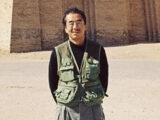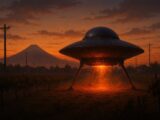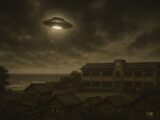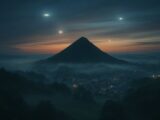The Man Who Met Aliens on a Japanese Mountaintop: The Incredible True Story of Yusuke Matsumura
The Man Who Met Aliens on a Japanese Mountaintop: The Incredible True Story of Yusuke Matsumura

It was the night of July 10, 1959.
A man had just finished a meeting in Tokyo and arrived at Sakuragichō Station in Yokohama around 11:30 PM. It was late, and with no taxis in sight, he began the long walk home through the deserted streets.
As he turned a corner, the headlights of an approaching car illuminated the silhouettes of three women walking toward him. As they passed, the face of the woman on the far left caught his eye. She seemed to offer him a strange, knowing smile.
He walked another ten paces before an odd feeling made him glance back. The three women were gone. He was on a straight road with no side alleys for them to have vanished into. Puzzled, he looked up at the sky. There, hovering silently, was an object the size of a football. It floated majestically over the roof of a nearby theater before disappearing.
This man was Yusuke Matsumura, and this encounter would change the course of Japanese UFO history forever.
The Most Controversial Figure in Japanese Ufology
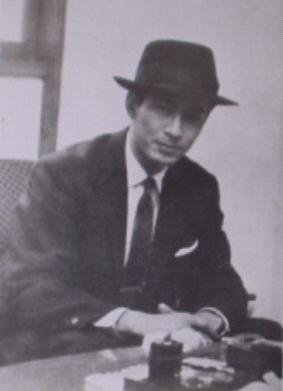
Yusuke Matsumura was the co-founder of the Cosmic Brotherhood Association (CBA), one of Japan’s most influential and notorious UFO research groups. In the annals of Japanese ufology, perhaps no figure is as polarizing as Matsumura.
To rival UFO organizations, he was the man who turned the CBA into a cult-like entity, culminating in the infamous “CBA Incident,” a doomsday prophecy that rocked the nation. Yet, to others, he was a pioneering researcher who maintained close ties with international figures like Brinsley Le Poer Trench and George Hunt Williamson. For years, he served as the Japan correspondent for the prestigious British publication Flying Saucer Review.
He was also one of Japan’s very first “contactees”—an individual claiming direct communication with extraterrestrials. So, who was the real Yusuke Matsumura?
A Life Defined by the Dawn of the UFO Age
Born in Yokohama in 1929, Matsumura’s life was tied to the skies from an early age. His father worked in the aviation industry, and as a boy, Matsumura moved to Manchuria (a region in Northeast Asia then under Japanese control), where at 16, he entered a flight crew training program. After World War II, he was briefly detained in Siberia before returning to Japan in 1946, where he became a correspondent for the international aviation magazine Interavia.
The following year, in 1947, the famed Kenneth Arnold sighting occurred in the United States, officially ushering in the modern UFO era. With his access to global aviation news, Matsumura was aware of the phenomenon from the very beginning. He formed his own research group and began publishing a newsletter in English called UFO News Report.
When the Japan Flying Saucer Research Association (JFSA) was formed, Matsumura and his group collaborated, and he became a frequent contributor to their journal. He was a signatory to the 1957 “Space Peace Declaration,” a joint statement by Japanese UFO groups.
A UFO photograph he took on January 16, 1957, was highly praised by other organizations. But at this point, Matsumura was a skeptic when it came to contactee stories like those of George Adamski. When the head of the JFSA planned to publish an article about American contactee Buck Nelson, it was Matsumura who warned him, “This man seems suspicious; you should stay away.”
This makes his next move all the more baffling. In August 1957, Matsumura, along with five others, founded the Cosmic Brotherhood Association (CBA). The group’s stated goal was to affirm the reality of contact and establish friendly relations with aliens. Why would a contact skeptic co-found such an organization? The reasons remain unclear, but it may have been fueled by a rivalry with other leading researchers. Regardless, his extensive international network was seen as a valuable asset.
And then, as if by a twist of fate, the series of events beginning with the vanishing women on that lonely street would transform Matsumura from a skeptic into the CBA’s charismatic leader and star contactee.
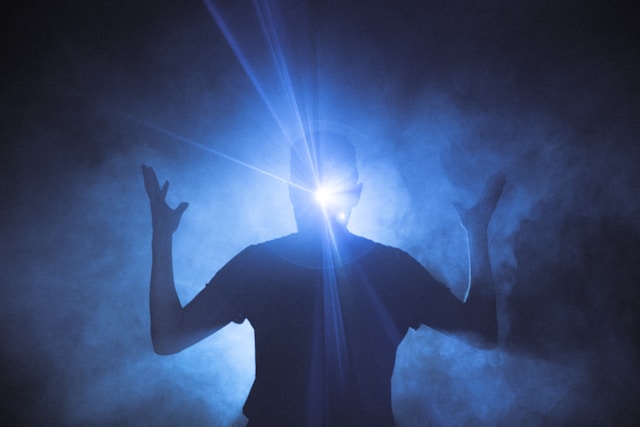
An Encounter with the Star People
The first hint of what was to come occurred on June 17, 1958. Matsumura was again at Sakuragichō Station, about to head to Tokyo. The station platform had recently been sprinkled with water to cool it down, and a set of footprints were clearly visible in the damp concrete. Matsumura froze. He recognized them instantly. They were identical to the footprints left in the desert sand by the Venusian that George Adamski claimed to have met.
Shaken, the once-skeptical Matsumura tried to follow the owner of the footprints, but the person had just boarded a departing train.
His first full-fledged contact happened one week after his UFO sighting, on July 17. Arriving at Sakuragichō Station during a sudden evening downpour, he ran for the streetcar, holding a portfolio over his head. As he ran, his arm brushed against someone. “Excuse me,” he said, turning around. It was her—the same woman with the enigmatic smile who had vanished a week earlier.
They went to a nearby coffee shop. The beautiful, Nordic-looking woman explained that she was an alien recently assigned to Japan. She told him that he would soon meet the commander of the alien forces stationed in the country. Matsumura noted a peculiar detail: when their coffee arrived, the woman poured the creamer into her glass of water and drank that, leaving the coffee untouched.
Three days later, on July 20, Matsumura met the commander. As he was walking up a hill in Tokyo’s bustling Shibuya district, someone tapped him on the shoulder. He turned to see a distinguished foreign gentleman with long, flowing hair. For some reason, Matsumura knew instantly that he was not of this world.
The man introduced himself as the “cap” of the aliens in Japan and made a promise. The CBA had declared July 25 as the “First All-Japan Contact Day,” a night when members across the country would attempt to summon UFOs. The designated location for the Tokyo group was the sacred Mount Takao. If a UFO appeared, the commander promised, Matsumura would be taken aboard.
Aboard the Mothership: A Chilling Revelation
On the 25th, Matsumura arrived at the summit of Mount Takao early. As the sun set, he saw a colossal UFO emerge from between the clouds in the western sky. It vanished quickly, but Matsumura was now certain. He was going to be taken.
The next morning, guided by telepathy, he went to a designated spot. There, a saucer about 100 feet in diameter was waiting on the ground. Its upper section resembled the craft Adamski had described, but the lower part was rounded with no visible landing gear. A hatch opened on its side, a ladder extended, and an alien crew member welcomed him aboard.
After a short flight of about 15 minutes, they arrived at a mothership. Stepping out into a docking bay, Matsumura found himself on a vast thoroughfare nearly a mile long, teeming with people of all nationalities, like a busy street in Tokyo. He was led to a massive room where a council of aliens sat at a semi-circular table. An elderly-looking being, clearly the Elder, sat in the center. Matsumura was invited to sit before him.
At this time, the CBA was facing a crisis. Matsumura had been translating the book Look Up! by the American contactee brothers, the Stanfords. The book contained a terrifyingly specific prophecy: a cataclysmic pole shift would occur in 1960. The CBA was deeply divided on whether to publish this.
Matsumura seized the opportunity and asked the Elder about the prophecy. The reply was chilling.
“A great cataclysm on Earth is imminent. We are constantly observing your planet, but even we do not know the exact date. You have been chosen to help prepare for it. We wish to evacuate as many humans as possible to other planets to rebuild your civilization. But you must proceed with great caution and not create chaos.”
Charisma, Controversy, and a Final Disappearance
Matsumura continued to meet with the aliens, receiving instructions on how to prepare for the cataclysm. They repeatedly stressed the need for “caution” and later instructed him “not to use the newspapers.” However, a more radical faction within the CBA pushed for immediate action. In 1960, their plans were leaked to the Sankei Shimbun newspaper, sparking the nationwide “CBA Incident.”
Taking responsibility, Matsumura and the entire CBA executive board resigned. But less than a year later, he was reinstated as director. Under his charismatic leadership, the CBA entered its most active and influential period.
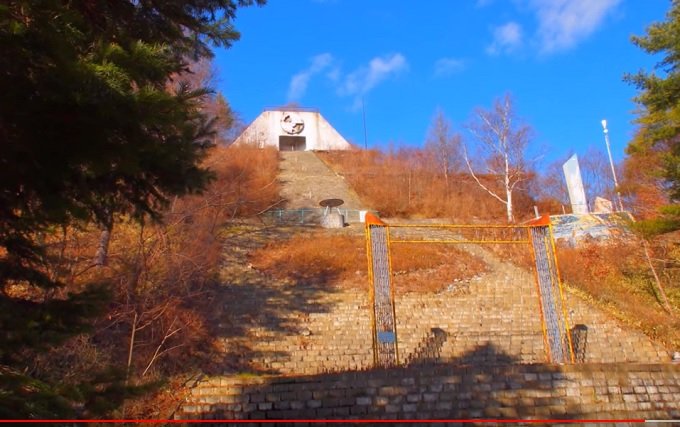
The group’s newsletters were upgraded to glossy, high-quality publications featuring ads from major corporations like Shiseido and Sony. They hosted a lecture tour for American researcher George Hunt Williamson in 1962. They launched ambitious expeditions to ancient Japanese sites, claiming connections between stone circles and burial mounds and ancient astronauts. It was the CBA that popularized the famous theory that the goggle-eyed Shakōki-dogū figurines were depictions of aliens, and they created the “UFO summoning” ritual of chanting “Ventla, Ventla” in a circle.
The culmination of these activities was the construction of a pyramid complex called Hayopira in Hokkaido. The project was built on land considered sacred to Oki-kur-mi, a cultural hero in the indigenous Ainu mythology, whom the CBA believed to be a friendly alien “Brother.” Volunteers from the CBA built the monuments by hand. In 1966, a grand ceremony was held to celebrate its completion, attended by dignitaries including British researcher Brinsley Le Poer Trench.
Construction continued until 1971. And then, shortly after, Yusuke Matsumura vanished.
To this day, the details of his disappearance are a mystery. He left without a word to his followers, and his whereabouts remain unknown. One account claims he died around the year 2000 while living quietly with a small Christian group in Kyoto.
But for those who followed his incredible journey, another, more fantastical possibility lingers. Perhaps Matsumura was finally taken away by his “Brothers,” transported by UFO to another world, where he continues to watch over the fate of humanity from afar.
References:
Flying Saucer News (August 1958 issue), Cosmic Brotherhood Association.
The History of the Cosmic Brotherhood Association (CBA), Cosmic Brotherhood Association.
Chikyu Roman (October 1970 issue), Gen’eisha Publishing.
What We Can Learn from Okikurumi Kamuy, the Ainu Cultural God, by Kiyoshi Amamiya (Triton Club).
※ Unauthorized reproduction, video creation, and uploading of this article's content to YouTube, blogs, or other platforms is strictly prohibited.
Related Articles

The Kofu Incident: Japan’s Most Terrifying Close Encounter

The Choshi Incident: Unraveling the Mystery of Japan’s Greatest Forgotten UFO Case

Japan’s Mysterious UFO Hotspot: Inside the Senganmori Mountain and International UFO Lab

UFO Over the Oregon Trail: A Japanese Nonfiction Travel Writer’s 1989 Encounter
Popular Series
This is the page for The Man Who Met Aliens on a Japanese Mountaintop: The Incredible True Story of Yusuke Matsumura. Find the latest news about YusukeMatsumura, CBA and more on TOCANA - the paranormal news media that stimulates your curiosity
UFO & UAP Latest Articles
The JAL Flight 1628 UFO Incident: Declassified Files Reveal a 50-Minute Encounter Over Alaska
2025.09.09 23:00 UFO & UAP